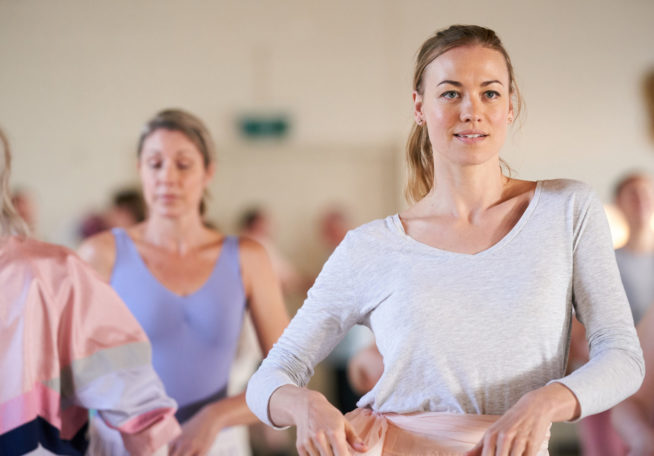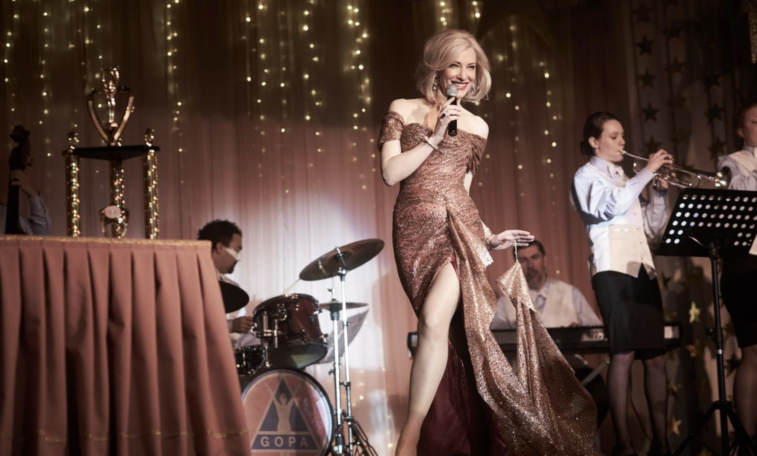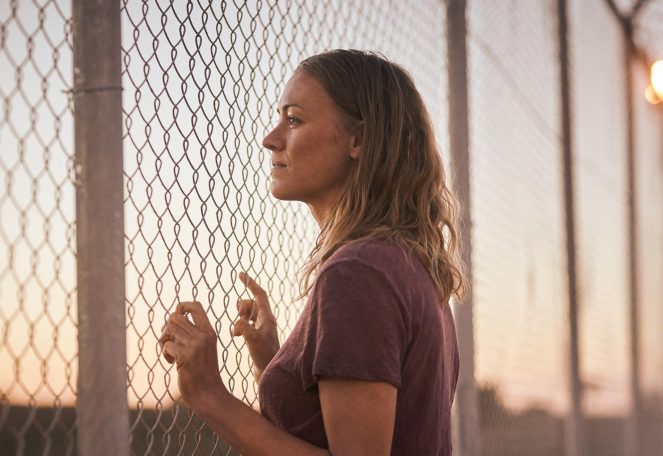If you didn’t watch the ABC television series called Stateless, then you can now view it on Netflix.
The show purports to raise an important issue we rarely see on our screens – that of asylum seekers.
And yet, despite all the publicity the show has raised about the very real issue of refugees and asylum seekers – this important topic seems to be secondary to the main storyline which is all about a ‘white girl’ who somehow accidentally ends up in a detention centre.
Executive producer, Cate Blanchett, and writer, Elise McCredie, are old school friends and they’ve said they were shocked to hear the story of a ‘white girl’ who ended up at Baxter Detention Centre in South Australia after several stints in correctional facilities.
The ‘white girl’ is Cornelia Rau – an Australian citizen of German descent. Blanchett and McCredie have said they were so fascinated by her story that they interwove it with three other storylines – and this is how they came up with television drama, Stateless.
But it does beg the question – can’t a story about refugees and asylum seekers stand on its own merit?
Do we really need to sensationalise this important topic with a more ‘interesting’ story about a ‘white girl’ who somehow ends up in a detention centre?
It seems that we do. By far the main character of the first episode of Stateless is Sofie (played by Yvonne Strahovski of The Handmaid’s Tale). We’re given all the details of Sofie’s background including her rather stern German family, who live in Sydney, Australia.

Sofie’s Story on Stateless
Sofie works as an airline stewardess and after a harrowing family Christmas dinner where she’s being set up with a potential partner, she escapes via her parents’ bathroom window (a scene which some reviewers have cited as ‘unlikely’) and soon after, we see Sofie dancing in a mesmerised state at a gathering of a group called GOPA.

Sofie becomes involved with GOPA and as other reviewers have written, this part of the storyline is not ‘wholly convincing’ and seems ‘over-the-top.’ GOPA is portrayed as a cult with Cate Blanchett and Dominic West playing the two leaders, Pat and Gordon.
Blanchett and West portray a grotesque pair of unlikeable ‘cult leaders’ but inexplicably, Sofie finds herself drawn into their influence.
Of course, things get worse and she becomes even more traumatised during her time at GOPA. When she leaves, we see her going for a swim and then shortly after, she turns up in the queue to enter a detention centre. How is this possible we ask?
Is this how it happened?
The makers of Stateless place this disclaimer at the beginning of the first episode: Although inspired by true stories the events and characters portrayed have been created for dramatic effect.
But the facts of what happened are available. Cornelia Rau was involved with a ‘cult’ when she was 32 years old. It was six years later when Rau was 38 that she was found at the Baxter Detention Centre in South Australia.
An investigation into the matter was held in 2005, called The Palmer Inquiry, and the ensuing report made no reference to the ‘cult’. Instead, the report examined all the checks and balances which were not adhered to, allowing the situation to occur.
But for drama’s sake, these elements of truth are not shown in Stateless and this renders the whole series a dramatic beat up with no resemblance to what were actually real-life events.

Does Stateless hit the mark?
There are two other storylines in the first episode of Stateless and this is perhaps where the real stories lie. We meet the Afghan family trying to flee Afghanistan so they can provide a better life for their two daughters. The father of this close family, Ameer, is played by Aussie actor, Fayssal Bazzi, and we see him constantly battling to ensure his family’s safety.
The other linking storyline introduces us to a young, local family man called Cam (played by Jai Courtney of The Suicide Squad fame). His friends tell him he should get out of his dead-end job as a boiler maker and become a detention centre guard. In the end, he follows their advice and we can see there’s now a lot more in store for him.
There’s one other storyline which we don’t see in the first episode but it’s part of the second episode. It’s here we’re introduced to our golden girl, Asher Keddie, when she arrives to play Clare – sent in to clean up the PR mess which unravels at the detention centre when it becomes clear that a ‘white girl’ such as Sofie, should not be there.

So – is it worth watching?
There’s been a lot said about how Stateless is beautifully shot and features a star-studded cast. It’s great to see the ABC investing in a drama production with all the costs this involves. And while the first episode disappointingly concentrates on Sofie’s sensational personal story, the other storylines do show more perspective about what it’s like to be sent to a detention centre or to work at a detention centre – perspectives we haven’t been privy to much before.
Whether this is enough to keep Stateless relevant remains to be seen in the ensuing episodes. Social media is already cooking on this one – some are upset that an opportunity to make a real statement about asylum seekers has been lost. Others are simply happy to see a story about refugees is finally gracing our television screens.








I think you make a really important point about the “white girl story”. However on the other hand I think this is a very clever tool which is likely to engage a much larger audience than a story only about asylum seekers. I think many Australians are either have compassion fatigue or chose to ignore and actively refuse to emotionally connect with the issue. The various other story lines provide some releif from what weould otherwise be a completely harrowing and depressing watching. I really do think this is likely to engage a wider audience. Including those who may not already be inclined to empathise with asylum seekers.
While taking your point about the “white girl story” and how its sad we need to cusion the story of asylum seekers. I really do think the story of Sophie, is infact a really interesting story in its own right, exploring other important contemparary Ausralian issues: mental health and cults. I didnt really find it to be as unbeliveable as you indicated. And I dont think it natters that it didnt totally stick to the origial true story. As is the story of the family who work/ visit the detention centre.
Its also too early to tell from from episode 2, however the Sophie story has set up for a potentially excellent comparison between how we treat ‘white’ immigrants and ‘non-white’ immigrants. If we as watchers/ Australians are horrified by the idea that a “nice white Australian girl” could end up in a remote detention center. Then it also forces us to ask: how are many in our country are ok with doing that to other non -white non-Australian human beings.
I also think its important to note and admire how accurately the series portrays the asylum seeker characters and the detention center. The characters have depth and are not reduced to steryotypes. The show also helps us to connect with them with empathy and some humour as well. As someone who has worked with Hazara and Tamil refugees over a number of years, I was really impressed with jow the asylum seeker characters and the detention center are depicted.
Looking forward to seeing how the series unfolds! ???? Thanks for your article.
Also just FYI, Baxter Detention Center was in South Australia, not Queensland.
We really appreciated your comments Katherine. Thank you!!
Ok thanks, we will check and correct this.
Absolutely loved the story and finally understand and have more compassion for asylum seekers.
“Sofie becomes involved with GOPA and as other reviewers have written, this part of the storyline is not ‘wholly convincing’ and seems ‘over-the-top.’ GOPA is portrayed as a cult with Cate Blanchett and Dominic West playing the two leaders, Pat and Gordon.
Blanchett and West portray a grotesque pair of unlikeable ‘cult leaders’ but inexplicably, Sofie finds herself drawn into their influence.”
Cornelia Rau was involved with KENJA – check its background for affirmation of the story of “GOPA”.
Interesting
That’s good to hear
The blogger above has done your publication a disservice. As pointed out above, Gopa is based partly on Kenja Communication. The article quietly refers to 3rd parties who have supposedly drawn the series credibility into question, and Connellan tells us, many times, that a ‘white girl’ has been used, and in doing seems to suggest the series is a latte attempt at exposing serious issues. The ‘white girl’ is used in a sensationalist manner in first episode, Connellan continues, and she attempts to dismiss the episode hoping it gets a bit more serious later, and she wraps up by telling us social media has a mixed response, but conveys a luke warm response.
Connellan has missed a vital point however which she should have made at the outset. While she quietly subverts the series without declaring her hand, attempting to discredit the series in a soft manner, she is in fact a proxy for Kenja Communication. Pamela Connellan is, or has been a longtime member of Kenja Communication.
Her name, and qualifications are entered multiple times on the groups published yearly statements in the SMH and other papers over the last 15 years.
This is, seemingly, how the Kenja group handle their pr problems.
Nothing less than a full page apology is required to correct the misinformation seeded into the blog. Connellana position in the publication must be reconsidered.
Racist bigot Government should be the ones locked up. Not the desperate ones who risked their lives to not be murdered in their home country
It certainly brings out the emotions in people.
This is a good story loved it thanks for sharing this articles